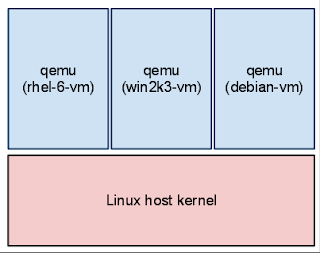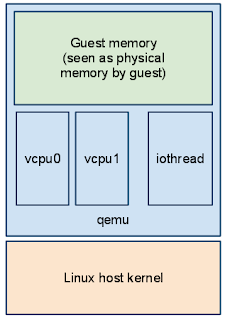【翻译】QEMU内部机制:顶层概览
系列文章:
- 【翻译】QEMU内部机制:宏观架构和线程模型
- 【翻译】QEMU内部机制:vhost的架构
- 【翻译】QEMU内部机制:顶层概览(本文)
- 【翻译】QEMU内部机制:内存
原文地址:http://blog.vmsplice.net/2011/03/qemu-internals-big-picture-overview.html
原文时间:2011年3月9日
作者介绍:Stefan Hajnoczi来自红帽公司的虚拟化团队,负责开发和维护QEMU项目的block layer, network subsystem和tracing subsystem。
目前工作是multi-core device emulation in QEMU和host/guest file sharing using vsock,过去从事过disk image formats, storage migration和I/O performance optimization
QEMU内部机制:顶层概览
在上一篇【翻译】QEMU内部机制:宏观架构和线程模型中,我直接介绍了QEMU的线程模型,并没有提到顶层的架构是什么样的。
本文将对QEMU顶层架构进行介绍,以帮助理解其线程模型。
vm的运行形式
vm是通过qemu程序创建的,一般就是qemu-kvm或kvm程序。在一台运行有3个vm的宿主机上,将看到3个对应的qemu进程:

当vm关机时,qemu进程就会退出。vm重启时,为了方便,qemu进程不会被重启。不过先关闭并重新开启qemu进程也是完全可以的。
vm的内存
当qemu启动时,vm的内存就会被分配。-mem-path参数可以支持使用基于文件的内存系统,比如说hugetlbfs等。无论如何,内存会映射至qemu进程的地址空间,从vm的角度来看,这就是其物理内存。

qemu支持大端和小端字节序架构,所以从qemu代码访问vm内存时要小心。字节序的转换不是直接访问vm的内存进行的,而是由辅助函数负责。这使得可以从宿主机上运行具有不同字节序的vm。
kvm虚拟化
kvm是linux内核中的虚拟化特性,它使得类似于qemu的程序能够安全的在宿主cpu上直接执行vm的代码。但是必须得到宿主机cpu的支持。当前,kvm在x86, ARMv8, ppc, s390和MIPS等CPU上都已被支持。
为了使用kvm执行vm的代码,qemu进程会访问/dev/kvm设备并发起KVM_RUN ioctl调用。kvm内核模块会借助Intel和AMD提供的硬件虚拟化扩展功能执行vm的代码。当vm需要访问硬件设备寄存器、暂停访问cpu或执行其他特殊操作时,kvm就会把控制权交给qemu。此时,qemu会模拟操作的预期输出,或者只是在暂停的vm CPU的场景下等待下一次vm的中断。
vm的cpu执行任务的基本流程如下:
open("/dev/kvm")
ioctl(KVM_CREATE_VM)
ioctl(KVM_CREATE_VCPU)
for (;;) {
ioctl(KVM_RUN)
switch (exit_reason) {
case KVM_EXIT_IO: /* ... */
case KVM_EXIT_HLT: /* ... */
}
}
从宿主机视角来看vm的执行
宿主机内核会像调度其他进程一样来调度qemu进程。多个vm在完全不知道其他vm的存在的情况下同时运行。Firefox或Apache等应用程序也会与qemu竞争宿主机资源,但可以使用资源控制方法来隔离qemu并使其优先级更高。
qemu在用户空间进程中模拟了一个完整的虚拟机,它无从得知vm中运行有哪些进程。也就是说,qemu为vm提供了RAM、能够执行vm的代码并且能够模拟硬件设备,从而,在vm中可以运行任何类型的操作系统。宿主机无法“窥视”任意vm。
vm会在每个虚拟cpu上拥有一个vcpu线程。一个独立的iothread线程会通过运行select事件循环来处理类似于网络数据包或硬盘等IO请求。具体细节已经在上一篇【翻译】QEMU内部机制:宏观架构和线程模型中讨论过。
下图是宿主机视角的qemu进程结构:

其他信息
希望本文能够让你熟悉qemu和kvm架构。
以下是两则介绍kvm架构的ppt,可以了解到更多细节:
Jan Kiszka's Linux Kongress 2010: Architecture of the Kernel-based Virtual Machine (KVM)
我自己写的KVM Architecture Overview
===精选评论===
->/dev/kvm设备是由谁打开的?vcpu线程还是iothread线程?
它是在qemu启动时由主线程调用的。请注意,每个vcpu都有其自己的文件描述符,而/dev/kvm是vm的全局文件描述符,它并非专属于某个vcpu。
->vcpu线程如何给出cpu的错觉?它是否需要在上下文切换时维护cpu上下文?或者说它是否必须硬件虚拟化技术的支持?
是的,需要硬件支持。kvm模块的ioctl接口支持操作vcpu寄存器的状态。与物理CPU在机器开启时具有初始寄存器状态一样,QEMU在复位时也会对vcpu进行初始化。
KVM需要硬件的支持,intel cpu上称为VMX,AMD cpu上称为SVM。二者并不兼容,所以kvm为二者分别提供了代码上的支持。
->hypervisor和vm如何实现直接交互?
这要看你是需要什么样的交互,virtio-serial可以用于任何vm/host的交互。
qemu guest agent程序建立于virtio-serial之上,他支持json rpc api。
它支持宿主机在vm中调用一系列命令(比如查询IP、备份应用等)
->能否解释vm中的一个应用的IO操作流程是怎样的么?
根据KVM还是TCG、MMIO还是PIO,ioeventfd是否启用,会有多种不同的代码路径。
基本流程是vm的内存或IO读写操作会“陷入”kvm内核模块,kvm从KVM_RUN的ioctl调用返回后,将返回值交给QEMU处理。
QEMU找到负责该块内存地址的模拟设备,并调用其处理函数。当该设备处理完成之后,QEMU会使用KVM_RUN的ioctl调用重入进vm。
如果没有使用Passthrough,那么vm看到的是一个被模拟出来的网卡设备,此时,kvm和qemu不会直接读写物理网卡。他们会将数据包交给linux的网络栈(比如tap设备)进行处理。
virtio可以模拟网络、存储等虚拟设备,它会用一些优化方式,但是基本原理还是模拟一个“真实”设备。
->kvm内核模块是如何捕捉到virtqueue的kick动作的?
ioeventfd被注册为KVM的IO总线设备,kvm使用ioeventfd_write()通知ioeventfd。
trace流程为:
vmx_handle_exit with EXIT_REASON_IO_INSTRUCTION
--> handle_io
--> emulate_instruction
--> x86_emulate_instruction
--> x86_emulate_insn
--> writeback
--> segmented_write
--> emulator_write_emulated
--> emulator_read_write_onepage
--> vcpu_mmio_write
--> ioeventfd_write
该流程显示了当vm kicks宿主机时,信号是如何通知ioeventfd。
原文如下:
QEMU Internals: Big picture overview
The story of a guest
A guest is created by running the qemu program, also known as qemu-kvm or just kvm. On a host that is running 3 virtual machines there are 3 qemu processes:

When a guest shuts down the qemu process exits. Reboot can be performed without restarting the qemu process for convenience although it would be fine to shut down and then start qemu again.
Guest RAM
Guest RAM is simply allocated when qemu starts up. It is possible to pass in file-backed memory with -mem-pathsuch that hugetlbfs can be used. Either way, the RAM is mapped in to the qemu process' address space and acts as the "physical" memory as seen by the guest:

QEMU supports both big-endian and little-endian target architectures so guest memory needs to be accessed with care from QEMU code. Endian conversion is performed by helper functions instead of accessing guest RAM directly. This makes it possible to run a target with a different endianness from the host.
KVM virtualization
KVM is a virtualization feature in the Linux kernel that lets a program like qemu safely execute guest code directly on the host CPU. This is only possible when the target architecture is supported by the host CPU. Today KVM is available on x86, ARMv8, ppc, s390, and MIPS CPUs.
In order to execute guest code using KVM, the qemu process opens /dev/kvm and issues the KVM_RUN ioctl. The KVM kernel module uses hardware virtualization extensions found on modern Intel and AMD CPUs to directly execute guest code. When the guest accesses a hardware device register, halts the guest CPU, or performs other special operations, KVM exits back to qemu. At that point qemu can emulate the desired outcome of the operation or simply wait for the next guest interrupt in the case of a halted guest CPU.
The basic flow of a guest CPU is as follows:
open("/dev/kvm")
ioctl(KVM_CREATE_VM)
ioctl(KVM_CREATE_VCPU)
for (;;) {ioctl(KVM_RUN)switch (exit_reason) {case KVM_EXIT_IO: /* ... */case KVM_EXIT_HLT: /* ... */}
}
The host's view of a running guest
The host kernel schedules qemu like a regular process. Multiple guests run alongside without knowledge of each other. Applications like Firefox or Apache also compete for the same host resources as qemu although resource controls can be used to isolate and prioritize qemu.
Since qemu system emulation provides a full virtual machine inside the qemu userspace process, the details of what processes are running inside the guest are not directly visible from the host. One way of understanding this is that qemu provides a slab of guest RAM, the ability to execute guest code, and emulated hardware devices; therefore any operating system (or no operating system at all) can run inside the guest. There is no ability for the host to peek inside an arbitrary guest.
Guests have a so-called vcpu thread per virtual CPU. A dedicated iothread runs a select(2) event loop to process I/O such as network packets and disk I/O completion. For more details and possible alternate configuration, see the threading model post.
The following diagram illustrates the qemu process as seen from the host:

Further information
Hopefully this gives you an overview of QEMU and KVM architecture. Feel free to leave questions in the comments and check out other QEMU Internals posts for details on these aspects of QEMU.
Here are two presentations on KVM architecture that cover similar areas if you are interested in reading more:
- Jan Kiszka's Linux Kongress 2010 presentation on the Architecture of the Kernel-based Virtual Machine (KVM). Very good material.
- My own attempt at presenting a KVM Architecture Overview from 2010.
转载于:https://www.cnblogs.com/qxxnxxFight/p/11058132.html
【翻译】QEMU内部机制:顶层概览相关推荐
- 综述|核心开发者全面解读Pytorch内部机制
↑ 点击蓝字 关注视学算法 作者丨Edward Z. Yang 来源丨机器之心 编辑丨极市平台 极市导读 Edward Z. Yang 是PyTorch开源项目的核心开发者之一.在PyTorch纽约聚 ...
- 在运行期通过反射了解JVM内部机制
在日常工作中,我们都习惯直接使用或者通过框架使用反射.在没有反射相关硬编码知识的情况下,这是Java和Scala编程中使用的类库与我们的代码之间进行交互的一种主要手段.但是,使用反射仅限于JVM内部运 ...
- 一文搞懂 PyTorch 内部机制
文 | ArchWalker 译者序:这篇博文是一篇非常新的介绍PyTorch内部机制的文章,作者Edward Z Yang来自于Stanford大学,是PyTorch的核心开发者之一.文章中介绍了如 ...
- Vue.js 运行机制全局概览
Vue.js 运行机制全局概览 全局概览 Vue.js 运行机制全局概览 这一节笔者将为大家介绍一下 Vue.js 内部的整个流程,希望能让大家对全局有一个整体的印象,然后我们再来逐个模块进行讲解.从 ...
- SQL Server 内存中OLTP内部机制概述(二)
----------------------------我是分割线------------------------------- 本文翻译自微软白皮书<SQL Server In-Memory ...
- Android驱动学习-内部机制_回顾binder框架关键点
内部机制_回顾binder框架关键点 server注册服务时, 对每个服务都提供不同的ptr/cookie, 在驱动程序里对每个服务都构造一个binder_node, 它也含有ptr/cookie c ...
- 【收藏】万字综述,核心开发者全面解读PyTorch内部机制
↑↑↑关注后"星标"Datawhale 每日干货 & 每月组队学习,不错过 Datawhale干货 作者:Edward Z.Yang,Pytorch核心开发者 斯坦福大学博 ...
- 全面解读PyTorch内部机制
点击上方"小白学视觉",选择加"星标"或"置顶" 重磅干货,第一时间送达 本文转自|深度学习这件小事 斯坦福大学博士生与 Facebook ...
- 浅谈ASP.NET的内部机制(一)
浅谈ASP.NET的内部机制(一) 前言:当一个Http请求发送给一个aspx页面时,服务器进行了哪些操作?又如何来解析这个请求?ASP.NET在接收请求后是怎么运行的,如怎么编译以及怎么样用托管的代 ...
最新文章
- 【数组方法大合集】原生js数组array常用工具方法大合集
- asp.net 2.0中一次性更新所有GRIDVIEW的记录
- 2019年度苏州之春摄影作品展
- 机器学习案例学习【每周一例】之 Titanic: Machine Learning from Disaster
- layui根据name获取对象_layui表格行合并;解决侧边固定栏合并
- IntelliJ IDEA中Spring Boot项目自定义Banner
- 第3个项目实操:用类与对象的方法编程
- redhat-5.4故障排除
- 在.net中使用sqlite
- 全面的SWOT分析的技巧和策略
- Android edittext 属性inputtype
- PyTorch搭建CNN-LSTM混合模型实现多变量多步长时间序列预测(负荷预测)
- Codeforces Round #521 (Div. 3) B - Disturbed People (贪心)
- 大数定理与中心极限定理
- html radio 默认选中
- Unity 人形动画、动画切割、Animator
- 小米红米1S 电信/联通版 专用TWRP2.8.1.1中文版 (全屏触摸/支持MTP挂载内外置存储)...
- 用好这两个键,你就是电脑高手啦
- 面向对象的六大原则之 接口隔离原则——ISP
- 选择适合自己的学习风格
